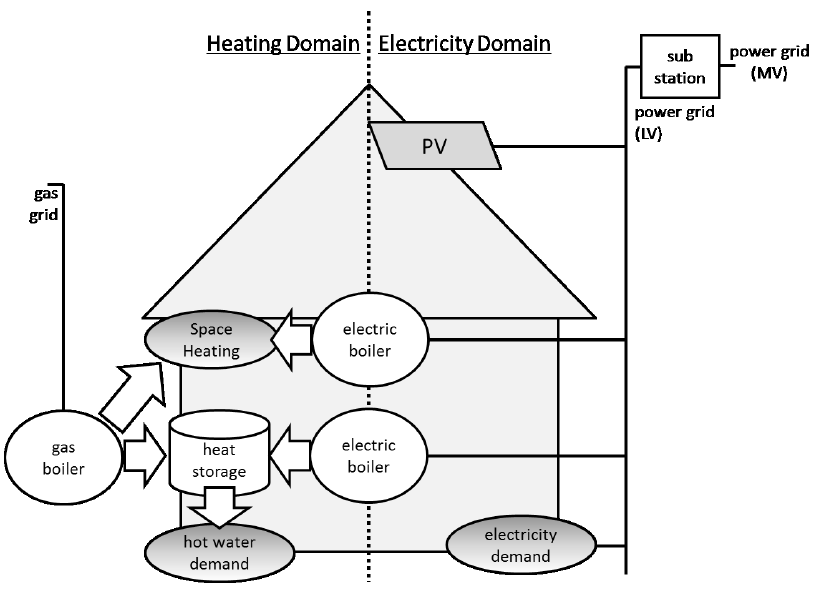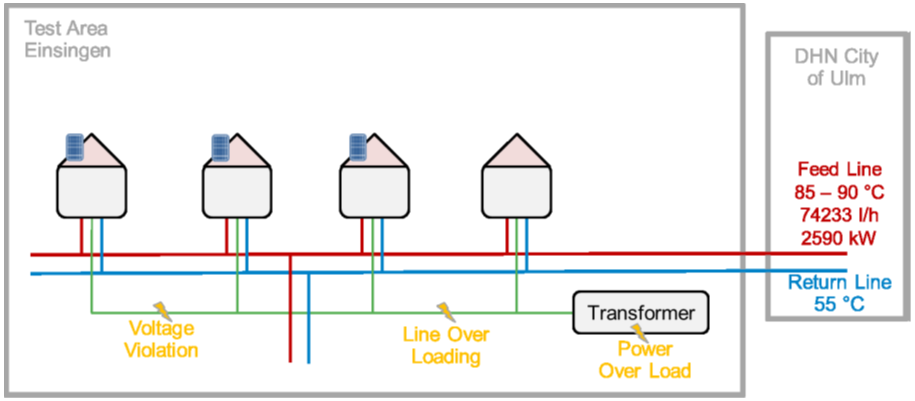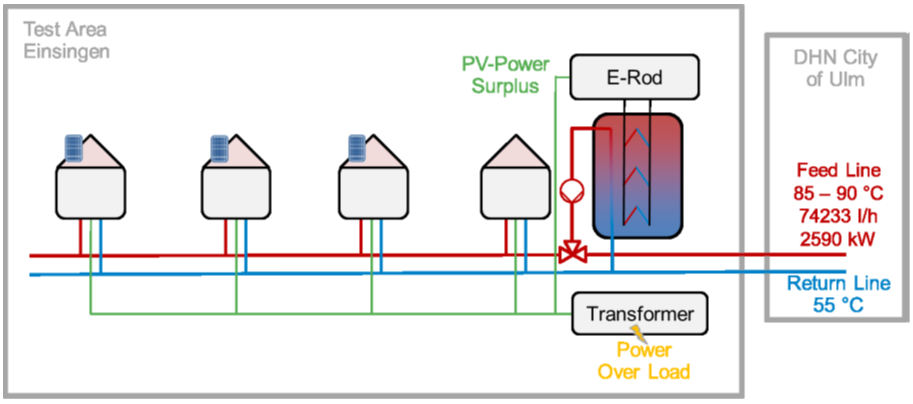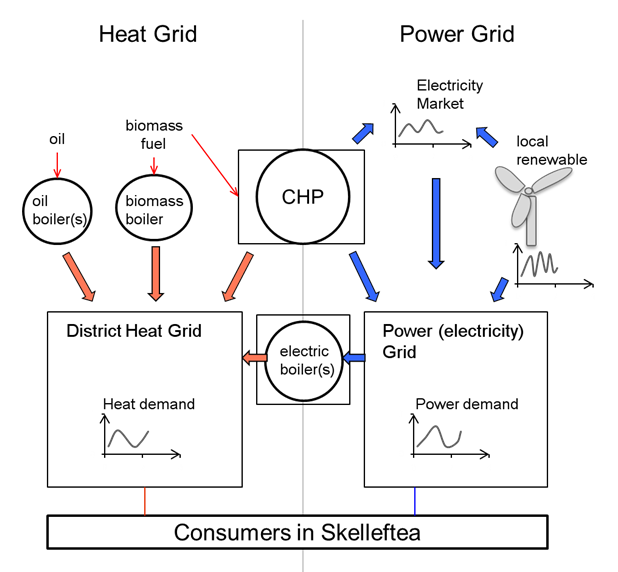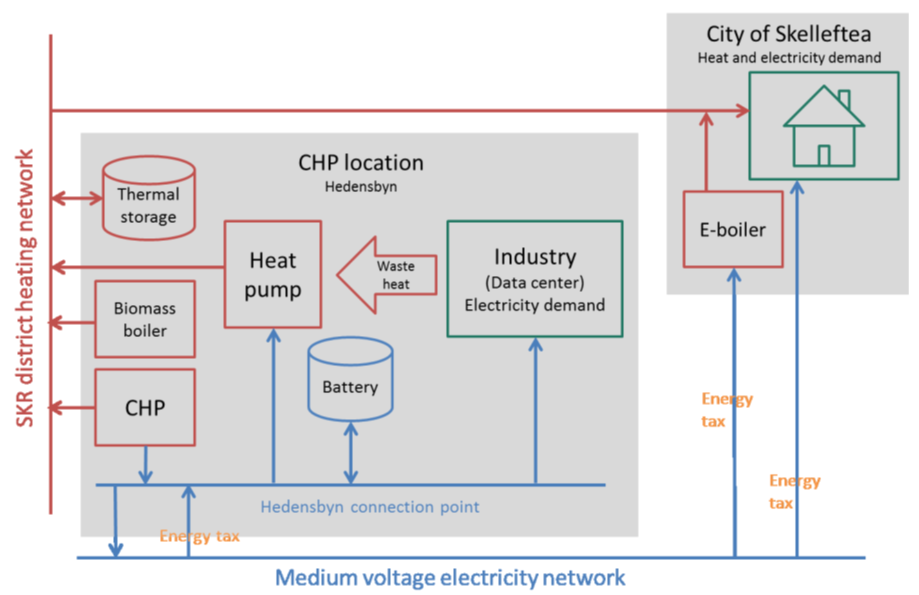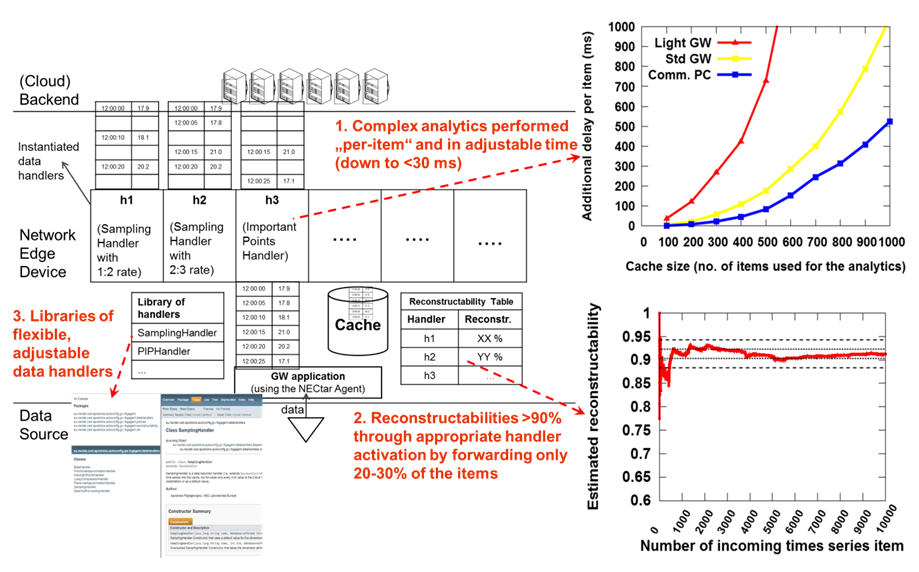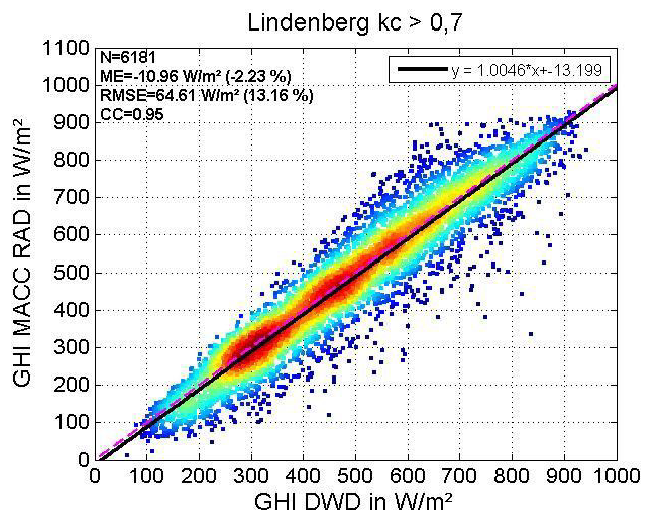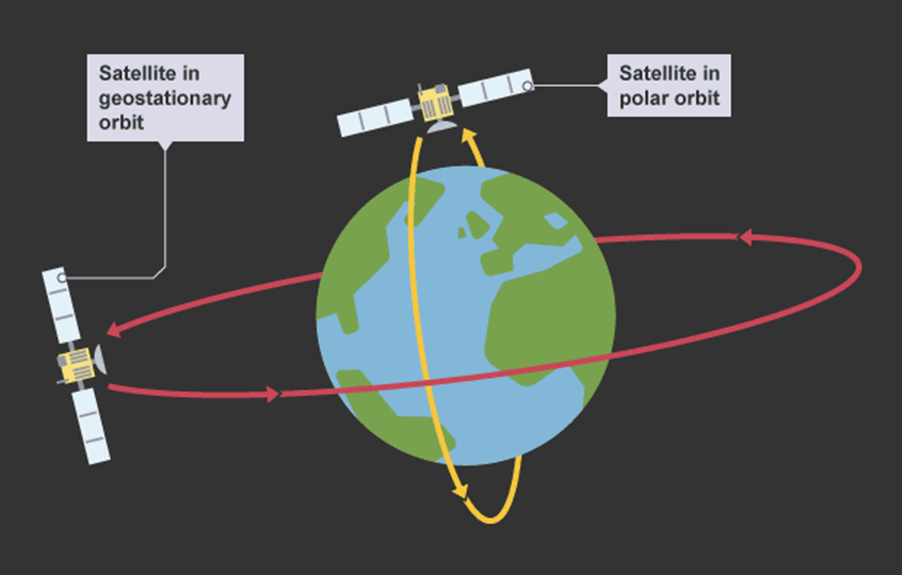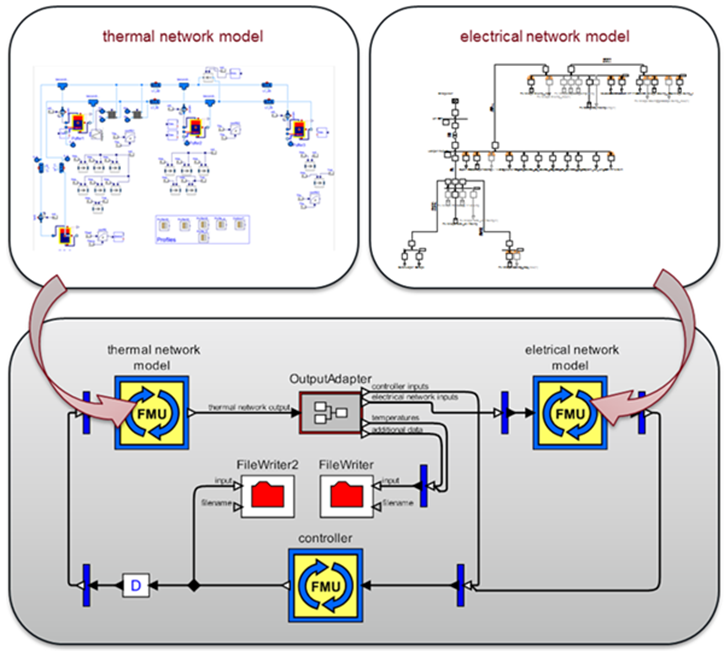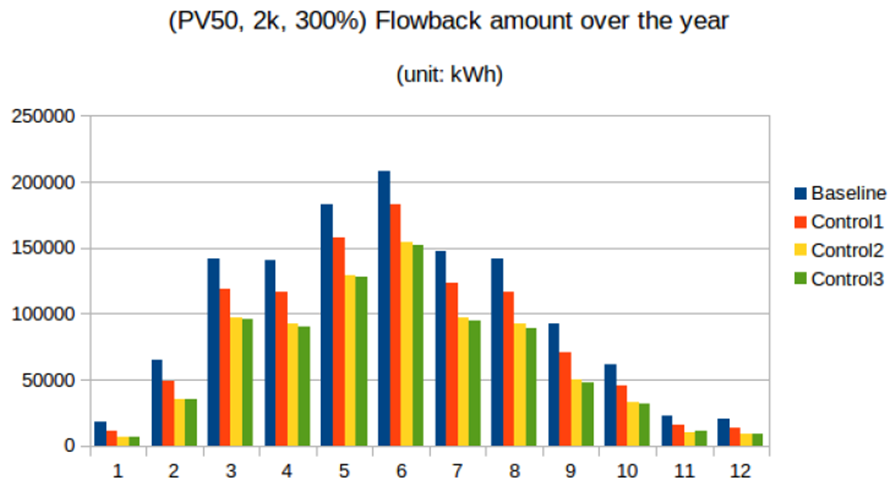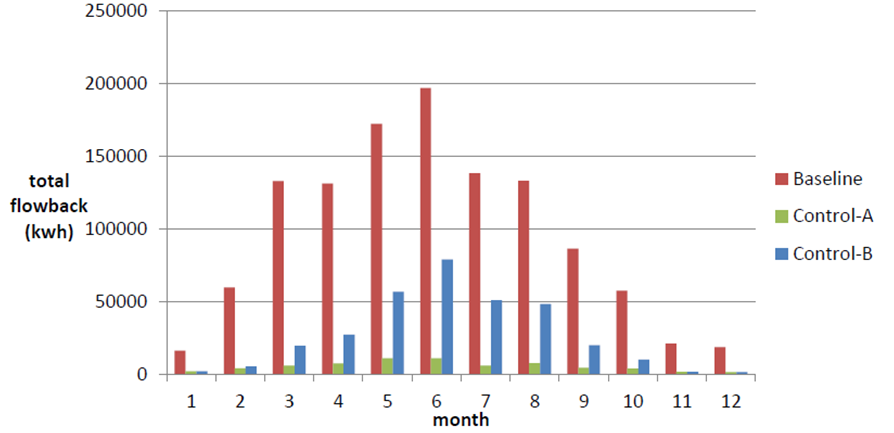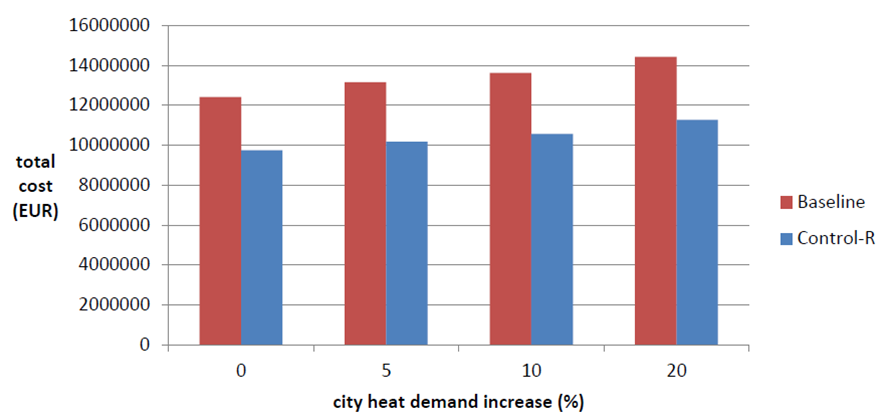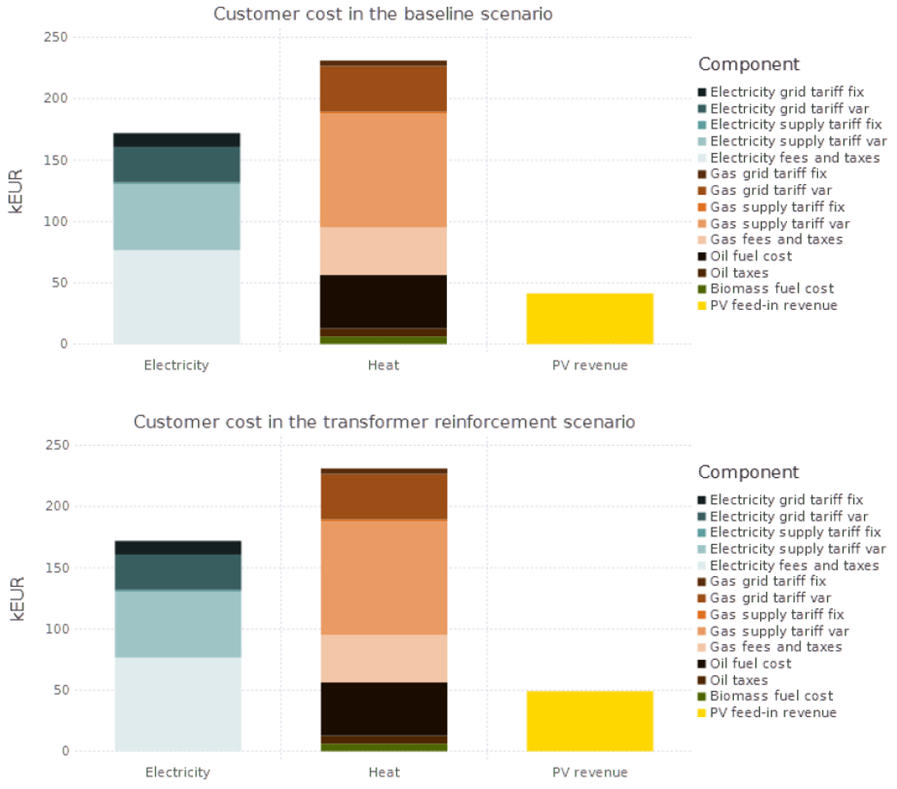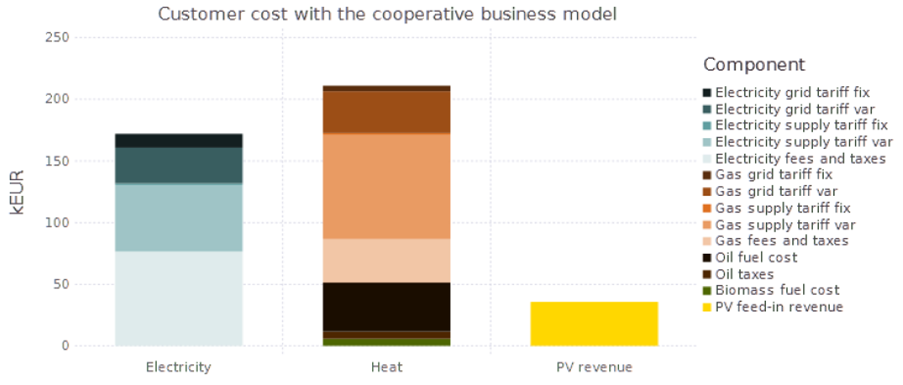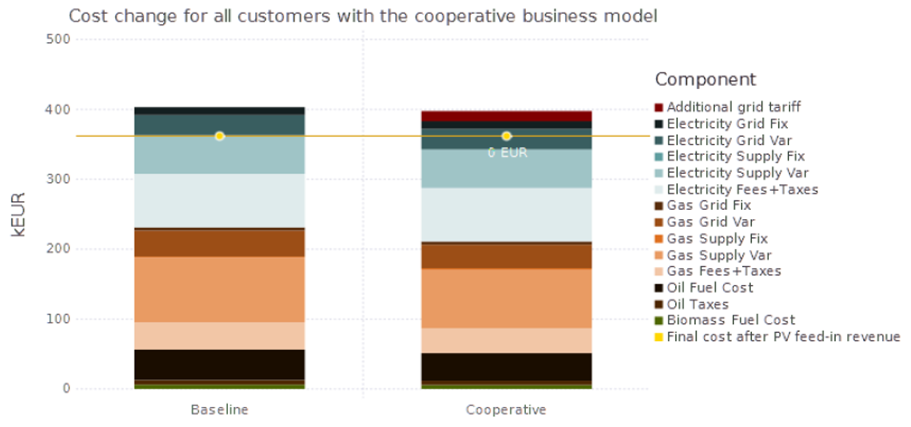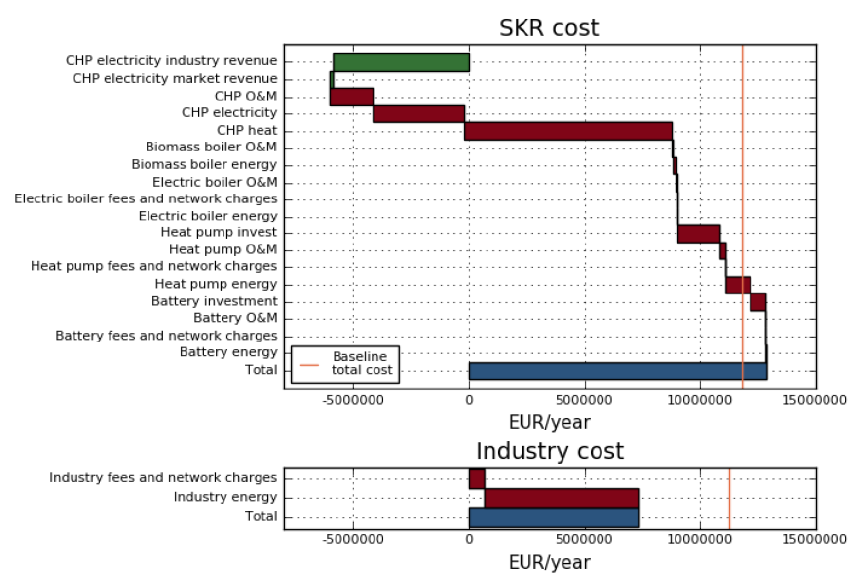Summary of results
From 2013 to 2016, the EU-funded OrPHEuS project investigated the concept of hybrid energy grids for smart cities.
The project investigations focused on two demonstration sites in Ulm (Germany) and Skellefteå (Sweden), representing typical use cases. A thorough assessment of the potential for technical and socio-economic benefits brought by the hybrid energy concept was conducted for these locations. From these results more general recommendations could be derived for a replication in other European contexts.
This page summarises the main project activities and results. First the demonstration sites are introduced, together with associated local issues to be solved and the proposed relevant hybrid energy grid concepts. An overview of the work conducted on the required smart-controlling architecture and effective procurement and processing of input data is then given. Results from the advanced modelling of scenarios based on various hybrid grid control strategies are presented, indicating benefits and drawbacks to be expected in each case. Finally, the main findings from a comprehensive socio-economic assessment are shown, including business model concepts allowing all actors to benefit economically from the proposed approaches.
- Hybrid energy grid concepts for the demonstration sites
- ICT infrastructure and data sourcing
- Cooperative control strategies
- Socio-economic impacts
- Replication and future developments
Hybrid energy grid concepts for the demonstration sites
The concepts presented below were explored through technical and economic simulations in order to provide the best value for involved stakeholders. For both demonstration sites, a scenario directly applicable to the existing context was developed and investigated. More advanced scenarios were furthermore included in the project work, reflecting possible future developments in Ulm and Skellefteå.
Demonstration site in Ulm, Germany
Local context
Einsingen and Hittistetten are residential neighborhoods in the suburbs of Ulm with a population of 400 and 300 inhabitants, respectively. These districts are particularly interesting for our studies due to their high level of PV penetration, with 21 PV systems installed on rooftops in Einsingen (peak capacity of 233 kW) and 58 PV systems in Hittistetten (peak capacity of 1.16 MWp). In addition to the electricity grid, the district is supplied by a gas grid which serves as the most common means of heating. Some households are furthermore equipped with boilers fueled from biomass, electricity, and oil.
Issues arise when high photovoltaic production occurs at times of low electric consumption, reversing the power flow at the power transformer supplying each district. As the transformer is unable to transmit the extra PV electricity from the local low-voltage to the medium-voltage grid, this electricity production has to be curtailed, which means it is lost. In addition peak PV production combined with low local demand can create overvoltage situations in the local grid. As more PV systems are expected to be installed in these areas, the issue is expected to worsen in the near future. A hybrid grid approach has therefore been proposed by the OrPHEuS project in order to overcome these problems. Hybridization is an attractive alternative to the much more costly grid reinforcement option, in which the power transformers and power lines have to be replaced by new equipment with larger capacity.
Hybrid energy grid approach for the present
The image below shows how new coupling points between the electric domain and the heating domain can be operated in a collaborative manner to increase the use of locally produced PV electricity. Electric boilers are installed and connected to the domestic hot water system in each household, in combination with an upgraded heat storage. A controller turns on the electric boilers at times of PV over-production in the neighborhood, which greatly reduces curtailment of the local PV electricity. As a result and as an added benefit fuel consumption for heating purposes is reduced.
Investigated coupling of electric and thermal domains in households in Ulm.
Several variations of the concept were investigated by the OrPHEuS project, studying the effects of different control strategies (aiming to maximize use of surplus PV electricity or minimize global costs), control infrastructures (from fully centralized to fully decentralized control), different electric boiler and heat storage sizes, and the potential benefits of using electric boilers for space heating as additional coupling points.
Hybrid energy grid approach for the future
An advanced hybrid grid concept was developed for a future scenario development in Ulm. In this scenario the districts of Einsingen and Hittistetten are connected to the district heating network of Ulm, which provides virtually unlimited import and export capacities for thermal energy.
Baseline concept for Ulm in the future scenario.
To solve the electricity network issues occurring in the baseline it is proposed to install a large electric boiler and heat storage directly connected to the district heating network, rather than individual electric boilers in each household:
Proposed grid hybridization in Ulm in the future scenario.
Compared to the first approach, the installation phase of this concept is expected to be easier on the technical and regulatory sides and overall more cost-effective for the local utility. On the other hand, less economic value would be generated by the sale of the produced heat as local district heating costs are lower than those of gas, oil and biomass otherwise supplying the household boilers.
Here also several variations of this hybrid grid implementation were studied, with different control strategies (maximizing heat export to the district heating grid versus maximizing local consumption of the generated heat), two different levels of PV penetration in the neighborhood and different electric boiler sizes.
Demonstration site in Skellefteå, Sweden
Local context
Skellefteå is a city of 32,000 inhabitants located in Northern Sweden. Heating for the city is provided by a district heating network, supplying about 343,000 MWh per year. Base load for the heating is supplied by a combined-heat-and-power (CHP) plant, which produces both heat (max 62 MW) and electricity (max 34 MW) from biomass. When more heating is required a biomass boiler is fired (max 25 MW), while peak-heating in winter is provided by oil boilers. These peak oil boilers are expensive to run and to maintain, especially as they are used for a very limited amount of time every year. At the same time, electricity produced at the CHP plant is sold on the power market.
In its efforts to reduce CO2 emissions and operating costs the local district heating grid operator wants to phase out the peak oil boilers, replacing them by a cost-effective sustainable alternative. In particular, electricity produced locally from biomass by the CHP plant and regionally by recently installed wind farms is considered as an option to answer this demand and increase flexibility in the heat production portfolio.
Hybrid energy grid approach for the present
A large-scale electric boiler is added to the system as a coupling point between the electrical and district heating grids in Skellefteå. All controllable system components are operated according to a collaborative control strategy reacting to heat demand levels and the price of electricity on the market. In winter conditions characterized by high heat demand and low electricity prices (with abundant wind) the electric boiler is turned on. With a sufficiently large electric boiler and heat storage the peak heat production from the oil boilers can be totally replaced and the oil boilers can be decommissioned.
Overview of energy interactions in the present scenario for Skelleftea.
The main question to be answered in this set-up is whether the oil boilers can be completely phased out, and whether this can be achieved with lower costs to the overall system. Different variations of the scenario were studied in order to provide the most relevant results. The investigated parameters were the location of the added electric boiler (in the city or at the location of the CHP plant, out of the city), the size of the electric boiler, and the control strategy applied to the system (minimizing system costs or minimizing CO2 emissions).
Hybrid energy grid approach for the future
In this advanced scenario, the hybridization of energy grids proposed for the present in Skellefteå has been implemented. The electric boiler is assumed to be located in the city and the oil boilers have been completely phased out. It is additionally considered that a datacenter with a large, constant electrical consumption and considerable heat output is installed close to the location of the CHP plant. Datacenters are energy-intensive ‘server farms’ mostly serving as key physical components of the worldwide Internet infrastructure. They are becoming increasingly prevalent in Sweden, a trend expected to continue in the future, but any other industry with a similar profile would play a similar role in this scenario. A heat pump is added as an extra coupling point, using electricity and waste heat produced by the datacenter to supply thermal energy to the district heating network.
This way a synergic relationship can be found between the local utility and the datacenter: The utility benefits from a cheap heat source while the datacenter can benefit from affordable electricity supply from the CHP plant. The economic benefits are enhanced by the fact that the two entities are interconnected “behind the meter” from the point of view of the medium-voltage electric grid to which the CHP and datacenter location is connected. In consequence taxation and grid charges for the use of electricity can be avoided.
Overview of energy interactions in the future scenario for Skellefteå.
An electric battery is also connected at the location of the CHP and datacenter to add further flexibility in the system, and to generate economic benefits by charging and discharging based on varying electricity market prices.
In this context the main question is whether the advanced hybridization set-up can lower energy costs for the two market actors: the utility and the datacenter. Variations investigated to help answer the question include the amount of taxation on electricity procured from the medium voltage network (19,5 €/MWh or 0,51 €/MWh), the district heat demand (assumed constant or increased by up to 20% in the future), the size of the datacenter (from 10 to 40 MW of electrical load) and the battery size.
ICT infrastructure and data sourcing
Hybrid energy systems require an overarching data transmission and processing infrastructure, linking the different physical components through a so-called machine-to-machine (M2M) network. This architecture serves to transfer information about the system state to one or more controllers. Based on a chosen control strategy, algorithms coded in the controllers then send the control orders to the active system components.
Several aspects of the control infrastructure and data inputs required for hybrid energy grids were investigated in-depth during the course of the OrPHEuS project:
Internet-of-Things systems for smart cities
A challenge encountered when implementing fine-grained cooperative control strategies is the large amount of data to be monitored (input data), transferred, processed, and dispatched (output data), often in real time. This is especially true in the context of large ‘smart cities’, where data flows related to energy systems are only part of a more global Internet-of-Things (IoT) infrastructure serving various applications. Transmission and processing of these large data flows can require an expensive and energy-intensive infrastructure by itself.
To mitigate this issue the OrPHEuS project developed M2M data filtering platform extensions and algorithms, based on data from the Skellefteå demonstration site. The resulting innovative real-time data filtering solution reduces the volume of data transfer across the network by up to 80% while retaining reconstructed output fidelity of about 90%. “Horizontal” IoT platform architectures with parallel gateways were also devised to introduce more flexibility in data processing and forwarding. Recommendations on how these should be deployed, managed, and used were made based on examples from the hybrid energy grid domain. Further ICT recommendations were made with regard to the handling of additional data sources and stream processing techniques that could enhance M2M monitoring systems.
Summary of operation and achievements of the OrPHEuS data filtering solution.
Use of meteorological data
Monitoring data used as input to inform and control energy systems is typically based on sensors physically installed at the location of the various components. Hybrid energy grids may require a large number of these sensors to provide suitable input for advanced control strategies. Besides being expensive and requiring installation efforts, another limitation of ground sensors is that they lack the ability to generate forecasts.
The OrPHEuS project therefore considered the use of meteorological data as a way to reduce the need for on-site sensor installation, and to provide added value to control strategies through real-time and future weather information (“nowcasting” and forecasting). To start with, an assessment of the meteorological data needs from the point of view of the utilities at the demonstration sites was conducted. Specifications on required temporal and spatial resolutions for various use cases were elaborated. Project partners were then provided with practical guidance on how to access and best benefit from matching available meteorological sources, ranging from ground weather data to satellite observations.
The weather data considered the most interesting for the demonstration site of Ulm was solar irradiance, which is closely related to PV production. A functional tool was developed, able to calculate voltage flows at the transformer level based on irradiance derived from satellite-based observations or numerical weather predictions. With sufficient accuracy such a tool can successfully reduce the number of required ground sensors and reduce global operational costs.
Scatter plot comparing satellite-based global horizontal irradiance (left axis) against ground-based GHI (bottom axis) measurements for the Lindenberg location in Germany with a clear sky index higher than 0.7. Data sources: Copernicus Atmosphere Monitoring Service and Deutscher Wetterdienst.
For Skellefteå, the main investigative effort was related to forecasting the district heat demand. It was found that outdoor temperature is logically the main demand driver, but in winter the relative humidity factor also plays a separate role and needs to be taken into account.
Recommendations on additional meteorological information needed for different use cases were given based on project results. Overall, the work conducted on the use of meteorological data to improve the operation of hybrid energy grids is largely based on data sources available on the global scale, often for free, and can relatively easily be replicated for other locations. The use of frequent satellite measurements for the estimation of solar irradiance is however constrained by the location of the geostationary orbit around the Earth, which limits observations to the 60° latitudes (North and South). Less frequent but higher-resolution irradiance measurements can be obtained for locations above 60° from satellites on a polar orbit.
Schematics of trajectories and altitudes for weather satellites in geostationary and polar orbits
While conducting this task it was found that the use of advanced meteorological information by energy utilities is currently limited by the unavailability of purpose-made data handling tools and overall by a lack of expert knowledge. Project members therefore support the training in Europe of experts working at the interface of both meteorological and energy system ‘worlds’. Recently started courses on energy meteorology for meteorology students are a step in this direction.
Cost efficiency through the combination of measured and simulated inputs
As previously mentioned one identified challenge for utilities when considering the implementation of hybrid energy grids is the high costs for data acquisition, transmission and processing. A large number of energy sensors and smart meters would in particular be needed to provide the required granularity of measurements. In the typical example of the Ulm demonstration site, expensive smart meters would have to be installed in every household.
In OrPHEuS an alternative approach was proposed, in which a reduced number of sensors located at key locations would be used in combination with weather data (ground and satellite measurements) and software simulations to provide a similar but more cost-efficient service. The use of domain-specific software was proposed, such as PowerFactory for the electric grid, Dymola for heating systems, and Stanet for gas grids. With the proposed setup, future and present grid voltage values could be sufficiently accurately estimated at different system nodes in Ulm based on ambient temperature and solar irradiance levels, for example.
An economic analysis comparing the baseline approach with the proposed one showed cost-efficiency improvements in the range of 125% to 230% in Ulm when considering a 15-year time horizon. While these theoretical results have to be considered with care, as observed smart meter prices are quickly going down, it was shown that a high potential exists for the innovative approach to the benefit of utilities and distribution system operators (DSOs).
Cooperative control strategies
The assessment of cooperative control strategies for the different energy sub-systems composing hybrid energy grids was at the center of the OrPHEuS project. Concepts considered included the replacement of energy sources (e.g. replacement of oil boilers), modifications to current infrastructure (e.g. location of additional boilers and/or storages), addition and/or modifications to the provision of space heating, up to further future concepts with deeper system transformations.
Co-simulation approach
The work conducted on control strategies is based on fine-grain modelling of the demonstration sites’ energy systems according to a ‘co-simulation’ setup. State-of-the-art simulation tools for electricity (PowerFactory) and thermal (Modelica) domains were adapted by project partners to allow their coupled operation, enabling a dynamic multi-physics simulation of the hybrid system. This way the implementation and impact of new control strategies for the whole simulated system could be analysed in both operational and planning terms. When assessing the feasibility of a potential implementation, this allows addressing a broad spectrum of stakeholders and facilitates the decision process.
Interactions between software components in the developed co-simulation environment
The developed co-simulation environment was designed according to the Functional Mock-up Interface (FMI) certification, so as to be adaptable and easily re-usable for modelling of hybrid energy grids in other contexts in the future.
Main findings for Ulm, Germany
Present scenario
Four control strategies (with many further variations) were modelled and analysed for the present, ranging between two extremes in terms of implementation costs and complexity. At one end of the spectrum electric boilers are only installed in households equipped with photovoltaic systems. They are switched on whenever PV production exceeds the household consumption, and surplus PV is exported to the grid only when the heat storage is full. This approach is purely decentralized and only involves PV owners. At the other end of the spectrum a fully centralized strategy was considered, where every element of the heat and electric grid systems is monitored through sensors and smart meters and processed by a central controller. Households without PV systems are also equipped with electric boilers and contribute to relieving the grid from voltage violations and making use of surplus PV. The topology of the electric grid is taken into account to react to node-specific issues.
Monthly PV curtailment at the power transformer in Ulm with 50% PV penetration and without provision of space heating. Control1: Fully decentralized; Control2: Intermediate; Control3: Fully centralized.
Simulation results show that the investigated grid hybridization is indeed effective in absorbing part of the PV surplus, thus reducing fossil boiler usage and problems in the electrical grid. When considering the fully centralized control strategy and a PV penetration of 50% the yearly curtailment at the power transformer level could be reduced by an estimated 35% compared to the status-quo scenario, with 30% reduction in summer months and 50% reduction in winter months. This would further result in a fossil fuel usage reduction of 60% over the full year, with 85% reduction in summer and 20% in winter. Benefits are also induced for the local low-voltage electric grid with a roughly halving of power transformer and node overload times over the year (from 10% to 5%).
It was however found that the proposed hybrid grid approach does not yield additional advantages when increasing the amount of PV generation in the area above 50% penetration, as there is not enough domestic hot water demand in households to make use of the surplus electricity above this threshold.
This barrier is overcome when electric boilers provide space heating in addition to domestic hot water, allowing a yearly reduction of PV curtailment of 65%. Fossil fuel usage is consequently reduced by 20% compared to the baseline, a figure not directly comparable to the previous results due to the added space heating load. The use of surplus PV electricity to produce space heating is however mostly constrained to the spring and autumn periods, when high solar irradiance is available while outdoor temperatures generate heating needs.
The inclusion of space heating as an option to make use of surplus PV electricity could also significantly reduce the need for sensors compared to the one considering only domestic hot water. It was found in the experiments that it is sufficient to observe (a) the PV overproduction (which is visible directly at the transformer in terms of flowback) and (b) the heat storage status at each coupling point, whereas benefits derived from additional sensor infrastructure could not be clearly confirmed. Making centralized control read the two aforementioned values and switch on devices to match the current surplus could turn out a sufficient level of awareness on the network state.
Future scenario
In the baseline future scenario all households are connected to the Ulm district heating grid, from which they satisfy all their domestic hot water and space heating needs. All the previously described problems on the electric side due to high PV penetration remain. In the proposed hybrid energy grid approach, a central electric boiler coupled to heat storage is connected to the district heating grid at the electric transformer location.
Two control strategies are modelled and compared. In the first strategy heat export from the electric boiler to the district heating grid is maximized whenever PV surplus occurs, and only constrained by the export capacity of the district heating grid. Whenever this capacity is insufficient the heat storage is charged instead, before being discharged as soon as the district heating grid has some unused export capacity again. In the second strategy the focus is on keeping the produced heat in the storage for local usage rather than exporting it. This strategy discharges the heat storage only by the amount of the current local heat demand, and heat is exported to the grid only when the storage is full.
Monthly flowback (curtailment) at the power transformer with 50% PV penetration and infinite district heat export capacity. ’Control-A’ is the strategy maximising heat exports to the district heating grid and ‘Control-B’ is the strategy maximising local usage for the heat.
Simulation results show that the control strategy maximizing heat exports results in considerably better reduction of PV curtailment, with a yearly reduction of 95% compared to the baseline. Heat imports from the district heating grid are also reduced in large proportions with both strategies, with a marginal advantage to the strategy prioritizing local heat storage when district heat export capacity is unlimited. In this case this strategy yields a yearly reduction in external district heating supply of 15% compared to the baseline, versus 10% in the heat export strategy. However on the electrical side neither strategy can provide much mitigation of the line and node overloads induced by the high PV penetration, as all power generated in the area still needs to flow to the centrally located electric boiler.
The control strategy based on the maximization of heat exports can then be preferred over the one maximizing local heat storage, as the benefits observed on the electric side (and particularly the spectacular reduction of PV curtailment at the transformer) largely outweigh slightly poorer performance on the heat demand side.
Main findings for Skellefteå, Sweden
Present scenario
In this analysis an electric boiler is added to the existing district heating grid in Skellefteå with the main aim of reducing the usage of oil boilers during peak heat demand periods in the winter. For this reason only winter months from November to March were included in the simulations.
Two cooperative control strategies are compared. The first one simply aims at completely phasing out the oil boilers by providing peak heating with the electric boiler. The second one aims to minimize yearly operational costs for the whole system, which means that oil boilers may be used at times when they prove more economical than the electric boiler. The control strategies are evaluated with many parametric variations considering electric market prices (affecting electricity sales revenue from the CHP unit, and the external purchase of electricity to operate the electric boiler), oil prices, outdoor temperatures (affecting peak heat demand) and boiler location. Thus optimal hybridization of the Skellefteå energy system can be derived according to key technical and socio-economic indicators.
Simulation results indicate an optimal sizing for the electric boiler of 35MW, and an optimal location next to the CHP plant rather than in the city. This is because electricity is on average cheaper when procured directly from the CHP unit compared to when it is bought from the grid in the city. It was further shown that such a boiler can successfully and cost-efficiently cover the totality of peak heat demand in typical conditions, and can therefore achieve the goal of phasing out the oil boilers. Higher-than-normal electricity prices in combination with low oil prices can however lead to better economics when operating the oil boilers at some critical times, even though the electric boiler would still provide most of the peak heating (97%) at lower costs. When considering harsh winter conditions, the coldest recorded in the past 25 years, the 35MW electric boiler capacity is not sufficient to cover all the peak heat demand and additional heating from the oil boilers is then required. In this case the oil boilers are needed to provide about 10% of the winter peak heating load.
The effect of implementing the electric boiler and hybrid energy control strategy is major when considering CO2 emissions from the oil boilers, the only direct CO2 emitters in Skellefteå’s energy system. In typical conditions the CO2 emissions can be cut by over 99%, from 840 to only 2.5 tons per year. At the same time total operational costs are only marginally affected compared to the baseline, with a reduction of about 1%, but a strong sensitivity to other economic and climatic parameters must be borne in mind.
Overall the control strategy based on cost minimization can be preferred over the one enforcing phasing out of oil boilers for the city, as the cost minimization approach manages significant CO2 reductions in a cost effective manner while allowing some degree of flexibility when very high heat demand cannot be covered solely by the electric boiler during the harshest winters.
Future scenario
In the modeled future scenario for Skellefteå, the baseline is based on the optimal configuration proposed for the grid hybridization in the present, with the 35MW electric boiler connected to the district heating line at the location of the CHP plant. A large datacenter is furthermore built in the direct vicinity of the CHP plant. The proposed advanced hybridization includes the use of waste heat from the datacenter by a large heat pump to provide district heating to the city, with the addition of an electric battery. Here only one control strategy is implemented and the results are compared to the baseline. The baseline uses only the means of hybridization available in the previous present scenario, and both control strategies target to minimize total operational costs.
The cost minimization takes into account cashflows for the utility only. Economic implications when considering the datacenter as well are presented in the next section. As in the present scenario only winter months from November to March are included in the simulations and a number of variations are analysed, including the increase of heat demand in the district heating network due to city growth and the size of the datacenter. In the baseline the city growth has led to a 20% increase in heat demand compared to the present and the datacenter is considered to have an electrical load of 20MW, with an equivalent waste heat output. The electricity tax incurred when using electricity from the grid to power the electric boiler, heat pump or battery is the present real-life value of 19,5 €/MWh.
Total costs for the utility in the future scenario for Skellefteå as a function of heat demand increase. ‘Control-R’ refers to the proposed hybrid energy approach and control strategy.
The simulation results indicate that with default parameters the new hybrid energy strategy yields a total operational cost reduction of about 20% for the utility regardless of the future heat demand increase in the district heating grid. Using this setup furthermore allows a reduction of 10-15% in the consumption of biomass for the CHP unit and biomass boiler.
Interestingly, it is found that battery operation does not provide any sizeable benefits to the system when considering battery capacities from 1 to 10 MWh. This is due to the small capacity of the battery compared to the larger scale of the energy system, and to relatively unfavourable economic conditions: benefits from charging the battery at low market prices and discharging it to the grid at high market prices are partly offset by the grid tariffs and taxes on the electricity bought from the grid.
Overall conclusions on control aspects
The modelling done in the OrPHEuS project demonstrated that the hybridization approach can provide consequent enhancements in key performance indicators (KPIs) such as cost, electrical grid impact, fossil fuel usage, and CO2 reduction. Various hybridization setups and control strategies varying in terms of data usage, conservativeness, and centralization were experimented with. The results show that centralized control strategies are preferable to decentralized ones in terms of almost all KPIs, which can be explained by a more holistic overview of the hybrid grids’ states. Decentralized strategies are still attractive because of their scalability and simplicity but require very careful control design in order to not perform sub-optimally. Seasonal variations are heavily influencing the outcome of the results in both studied demonstration sites, and must be thoroughly taken into account when assessing and planning the hybridization of energy systems.
Applicability and scalability of the developed control strategies and results to cities in other regions, with different energy networks, different means of energy exchange, and different supply and demand patterns was further analysed. It was found that there is a wide applicability of the particular hybridization approaches that have been studied in the project, and for these applications the proposed control approaches can be adopted. When dealing with scenarios which are by two or more orders of magnitude larger, additional computational and robustness issues have to be addressed by the control infrastructure. Recommendations on how to deal with communication and computation scalability have therefore been given by the OrPHEuS consortium.
Socio-economic impacts
Beyond the previously presented economic parameters used to assess the benefits of hybrid energy control strategies, a more holistic socio-economic investigation was carried out during the project. The present and future scenarios for the demonstration sites were evaluated in terms of costs and benefits for the different participating actors. With the conduction of sensitivity analyses and robustness tests, the consortium could issue recommendations for new collaborative business models offering an optimal allocation of costs and profits according to the Pareto criterion. With respects to this principle all involved stakeholders benefit from the implemented changes.
Main findings for Ulm, Germany
Present scenario
The economic analysis focused on the assumption of a rooftop PV penetration of 75%. Considering the use of surplus PV for the production of domestic hot water in the present scenario, the proposed hybrid energy approach would lead to yearly savings of about 15.000€ compared to the baseline in the district of Einsingen. This is roughly twice the savings which would be expected if the alternative grid reinforcement approach is chosen, meaning an upgrade of electrical lines and the installation of a new, larger transformer. The various cost components and revenues for households equipped with PV would also be impacted differently in these different approaches.
PV revenue from sale of the produced electricity to the grid would be reduced with the implementation of the electric boilers, but overall costs would be lowered thanks to the reduction in fossil fuel usage for heating. A new business model is necessary to ensure that everyone benefits from the proposed scheme in equal measures, otherwise households without PV systems would benefit from the reduction in fossil fuel usage without compensating the PV producers for their reduction in sales of PV to the grid.
An optimal business model benefitting both household categories equally is therefore proposed by slightly increasing and varying the repartition of the fixed and variable components of electricity bills paid to the local utility. The exact required values depend on the investment costs for the implementation of the electric boilers, control infrastructure, etc., but would not exceed 2.9 ct per kWh of shared PV surplus in the worst case.
Future scenario
When assessing the economics of the future hybrid energy grid scenario in Ulm, a major difference is that heat produced from surplus PV for district heating has a lower value than in the previous case: district heating in Ulm costs about 35€/MWh, which is much less than the fuel costs for individual boilers equipping households at present. As a consequence with typical investment costs for the installation of the central electric boiler and heat storage in Einsingen (above 130.000€) the proposed approach is uneconomical, with higher total costs compared to the baseline. Investment costs below 70.000€ are required to generate overall savings.
Assuming the latter low investment costs, if the utility operating the district heating system is willing to remunerate PV producers for the operation of the electric boiler, a win-win situation among heat supplier, PV and passive customers can be reached. In the assumed conditions the tariff paid by the district heat provider to PV producers to satisfy this condition would be about 16€ per MWh.
Main findings for Skellefteå, Sweden
Present scenario
The economic analysis for the present scenario in Skellefteå considered realistic investment, fuel and maintenance costs for the different technologies in the system, including the proposed central electric boiler. Results show that transitioning to the hybrid grid approach would result in lower total costs compared to the baseline for the local utility only when considering an increase in heat demand. This is a likely development according to present and foreseen city growth. Even in this case the profitability of installing and operating the electric boiler rather than the existing oil boilers is highly dependent on future oil and electricity prices, with total cost change for the utility varying from 3.5% savings in the best case (with oil prices 40% higher than current levels) to 0.5% extra costs in the worst case (oil 40% cheaper and electricity 20% more expensive).
With standard parameters and no increase in heat demand the utility would see its total costs increased by about 1% to 1.5% when opting for the installation of the electric boiler to provide peak heating. In this case, corresponding to the situation today, the oil boilers would be effectively phased out. Thus the proposed grid hybridization can cut CO2 emissions from the city to zero in a very cost-effective way.
An additional finding is that the scheme greatly benefits from the co-location of the electric boiler with the CHP unit, because electricity procured directly from the CHP for electric heating is not subject to grid charges and taxes otherwise imposed on the used electricity if the boiler is located in the city.
‘City’ and ‘CHP’ indicate the location of the electric boiler, while 24 and 35 MW correspond to the two considered boiler capacities. The ‘StatusQuo’ is the baseline situation, without electric boiler.
Future scenario
In the advanced, future scenario for Skellefteå, the main question is whether both the city and the datacenter can benefit economically from their energy interaction. Results show a strong dependency on the location of the datacenter, either at the CHP location or elsewhere in the city, and on the amount of the energy tax on electricity for the datacenter, either 19,5 €/MWh as at present or 0,5 €/MWh as already proposed for the future.
The overall best configuration when investigating the current tax level is found with the industry located at the location of the CHP. In this case the utility sees reduced profits from the sale of CHP electricity, as this electricity is now mostly sold to the datacenter rather than on the wholesale market. On the other hand the production of district heating is made cheaper thanks to the heat pump utilizing waste heat from the datacenter, reducing the usage of the biomass boiler. Overall the utility has marginally higher costs in this situation than in the baseline. But the datacenter can reduce its electricity procurement costs to a large extent, due to the favorable direct electricity procurement from the CHP unit and to the avoidance of the energy tax and grid charges.
Visualisation of cost and revenue components for the utility (‘SKR cost’) and the datacentre (‘Industry cost’) in the future scenario for Skellefteå. The orange vertical line indicates total costs in the baseline.
Thus, the combined costs of the two market players are reduced and a win-win situation can be achieved by shifting some of the benefits from the industry to Skellefteå Kraft. Of course the combined benefit is significantly lower with a low industry energy tax, because in this case already the baseline costs of the industry are significantly reduced. However, if the new technologies are located at the CHP location, both energy tax scenarios result in lower total cost compared to the baseline.
Cost change for Skellefteå Kraft and the industry compared to the baseline if a tariff is paid by the industry to Skellefteå Kraft in addition to the wholesale market price. The vertical red lines indicate the interval for an additional tariff, which both players can benefit with. The points where the two lines cross show the tariff, which yields equal benefits for both stakeholders.
Overall conclusions on socio-economic aspects
In both demonstration sites it has been shown that a hybridization of the energy supply chain and a stronger coupling of the energy distribution networks can significantly reduce the usage of fossil fuels in a cost-efficient manner. The usage of hybrid coupling points provides more flexibility – especially for the electricity network – and, thus, can be an important tool to further increase the share of renewable energy sources in Europe’s energy system.
Nevertheless, for some use cases strong assumptions regarding e.g. the regulatory framework (especially in Ulm) had to be made for the investigation of hybrid cooperative control strategies and major barriers have been identified. Firstly, the distribution system operator, who would in many cases be the predestined market participant to implement such cooperative hybrid business models has a lack of incentives to promote them: The allowed revenue of a distribution system operator is linked to the asset value of the distribution network in the regulative process and, thus, investing in capital-intensive grid reinforcement is more beneficial from his point-of-view. Secondly, the distribution system operator, who has detailed information about key operational figures in the network, is not allowed to trade energy and thus cannot operate coupling points in most situations. In this case a third party such as an aggregator would be required, which makes business model development more complicated as finding additional benefits for a new market player is not trivial.
Furthermore, the major barrier from an economic perspective for the implementation of hybrid business models is given by the network charges and electricity taxes for power-to-heat technologies. Even if in many situations it could be beneficial for both energy domains (excess renewable surplus in the electricity grid and cheap heating source in the district heating network), network charges and other electricity fees make such a cooperation economically inefficient. Thus, the business models having been identified as the most economic for the involved market participants are the ones aiming to avoid these charges by operating behind system boundaries (e.g. CHP and electric boiler or heat pump at the same location in Skellefteå).
Another lesson learned from the validation of the benefits in the demonstration sites is the fact that most business models are very sensitive to input parameters like energy prices and demand development. While some general conclusions could be drawn, most hybrid cooperative business model implementations would require a comprehensive location- or country-specific investigation.
Replication and future developments
The OrPHEuS project has studied five main energy hybridization scenarios for two target sites, each with a range of variations in terms of energy demand, supply, prices, and device configurations. The project results have therefore a very high potential for replicability in other related contexts in Europe.
The OrPHEuS consortium has published a series of practical recommendations to summarise the project findings and guide further applications of the hybrid energy grid concept, which are available on this page and touch upon the following topics:
- Control strategy design
- M2M architecture
- Need for meteorological information
- Business model development
- Socio-economic and regulatory relationships
The OrPHEuS partners plan to build on the project achievements to conduct further work on the hybrid energy grid concept and its application in smart cities. They can be contacted directly by readers wishing to be informed of or involved in these future developments.



